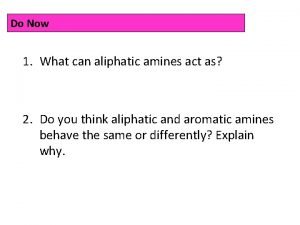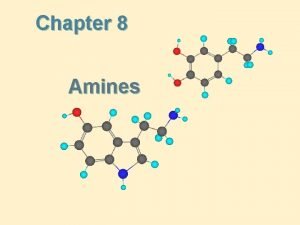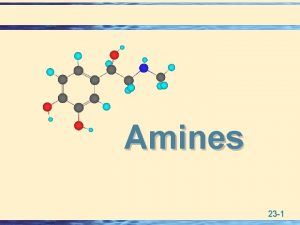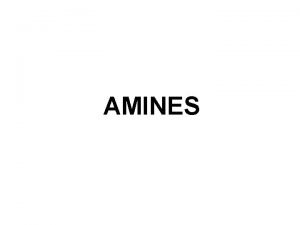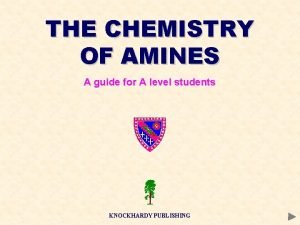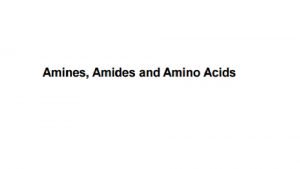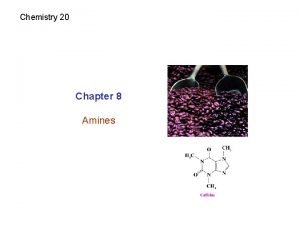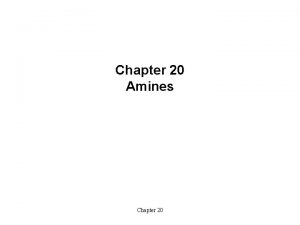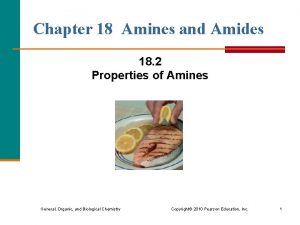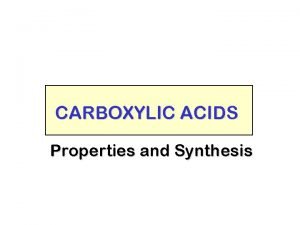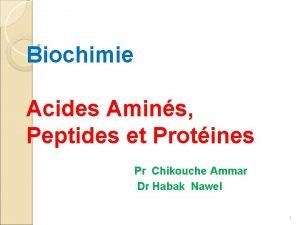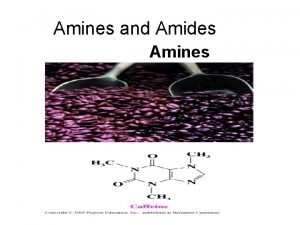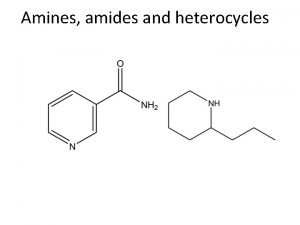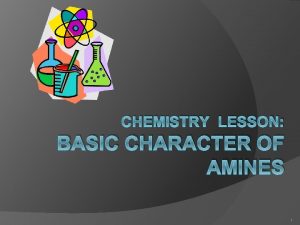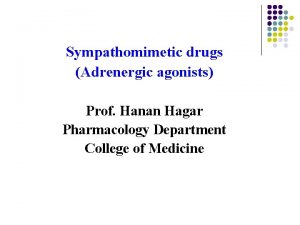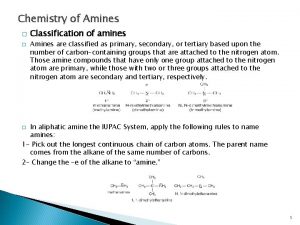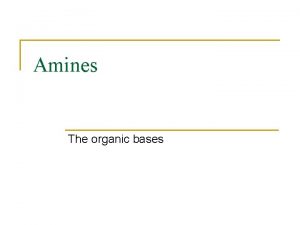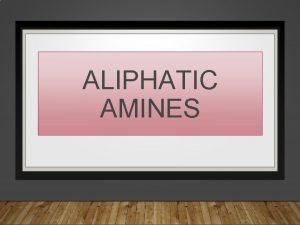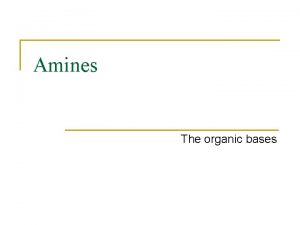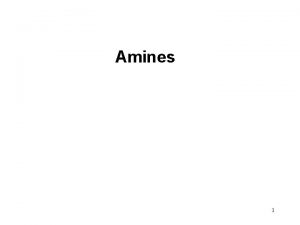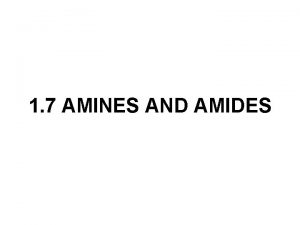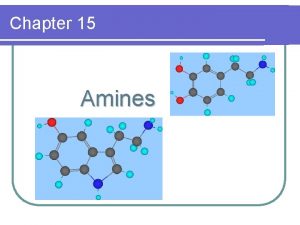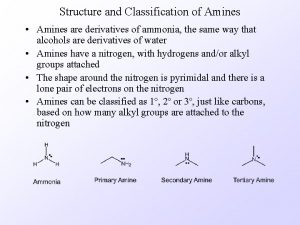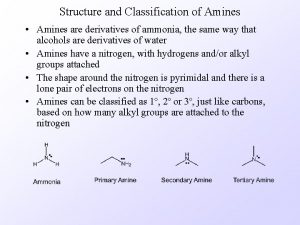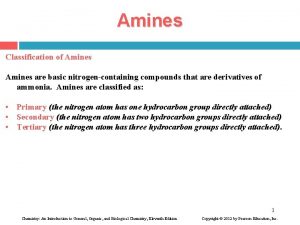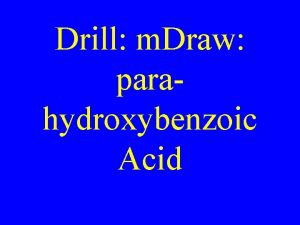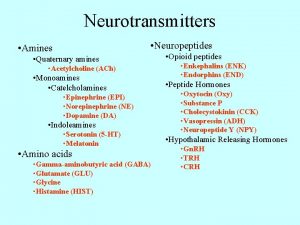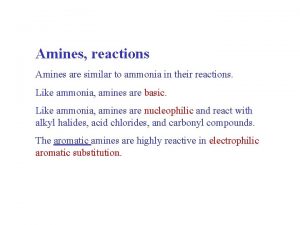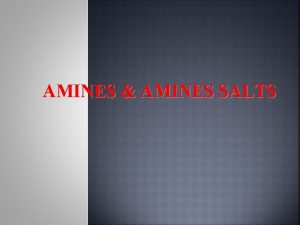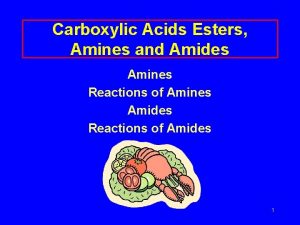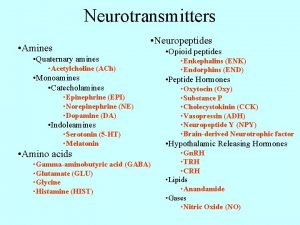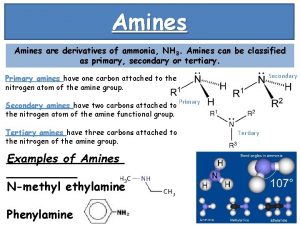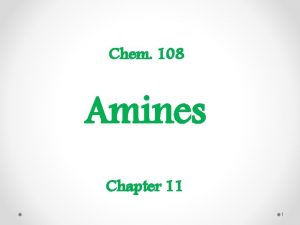Amines 23 1 Structure Classification u Amines are












































- Slides: 44

Amines 23 -1

Structure & Classification u Amines are classified as: • 1°, 2°, or , 3° amines: Amines in which there are 1, 2, or 1°, 2°, or , 3° amines: 3 alkyl or aryl groups. 23 -2

Structure & Classification u Amines are further divided into aliphatic, aromatic, and heterocyclic amines: • Aliphatic amine: An amine in which nitrogen is bonded amine: only to alkyl groups. • Aromatic amine: An amine in which nitrogen is bonded Aromatic amine: to one or more aryl groups. 23 -3

Structure & Classification • Heterocyclic amine: An amine in which nitrogen is one Heterocyclic amine: of the atoms of a ring. 23 -4

Nomenclature u Aliphatic amines: replace the suffix -e of the parent alkane by -amine 23 -5

Nomenclature u The IUPAC system retains the name aniline. 23 -6

Nomenclature u Among the various functional groups, -NH 2 is one of the lowest in order of precedence. Amine vs alcohol Amine vs acid 23 -7

Nomenclature u Common names for most aliphatic amines are derived by listing the alkyl groups bonded to nitrogen in one word ending with the suffix -amine 23 -8

Nomenclature u When four groups are bonded to nitrogen, the compound is named as a salt of the corresponding amine. 23 -9

Chirality of Amines • Consider the unshared pair of electrons on nitrogen as a fourth group, then the arrangement of groups around N is approximately tetrahedral. • An amine with three different groups bonded to N is chiral and exists as a pair of enantiomers and, in principle, can be resolved. 23 -10

Chirality of Amines • In practice, however, they cannot be resolved because they undergo inversion, which converts one enantiomer to the other. 23 -11

Chirality of Amines • Pyramidal inversion is not possible with quaternary ammonium ions, and their salts can be resolved. 23 -12

Physical Properties u Amines are polar compounds, and both 1° and 2° amines form intermolecular hydrogen bonds. • N-H- - -N hydrogen bonds are weaker than O-H- - -O hydrogen bonds because the difference in electronegativity between N and H (3. 0 - 2. 1 =0. 9) is less than that between O and H (3. 5 - 2. 1 = 1. 4). Using bp as an indication of H bonding Increasing strength 23 -13

Basicity u All amines are weak bases, and aqueous solutions of amines are basic. • It is common to discuss their basicity by reference to the acid ionization constant of the conjugate acid. 23 -14

Basicity • Using values of p. Ka, we can compare the acidities of amine conjugate acids with other acids. 23 -15

Basicity-Aliphatic Amines u Aliphatic Amines • note that p. Ka + p. Kb = 14 Stronger bases 23 -16

Basicity-Aromatic Amines Weaker bases Intermediate 23 -17

Basicity-Aromatic Amines • Aromatic amines are considerably weaker bases than aliphatic amines. 23 -18

Basicity-Aromatic Amines u Aromatic amines are weaker bases than aliphatic amines because of two factors: • Resonance stabilization of the free base, which is lost on protonation. 23 -19

Basicity-Aromatic Amines • The greater electron-withdrawing inductive effect of the sp 2 -hybridized carbon of an aromatic amine compared with that of the sp 3 -hybridized carbon of an aliphatic amine. And note the effect of substituents u Electron-releasing groups, such as alkyl groups, increase the basicity of aromatic amines. u Electron-withdrawing groups, such as halogens, the nitro group, and a carbonyl group decrease the basicity of aromatic amines by a combination of resonance and inductive effects. 23 -20

Example: Basicity-Aromatic Amines 3 -nitroaniline is a stronger base than 4 -Nitroaniline. Cannot do this kind of resonance in 3 nitroaniline 23 -21

Basicity-Aromatic Amines u Heterocyclic aromatic amines are weaker bases than heterocyclic aliphatic amines. 23 -22

Basicity-Aromatic Amines • In pyridine, the unshared pair of electrons on N is not part of the aromatic sextet. • Pyridine is a weaker base than heterocyclic aliphatic amines because the free electron pair on N lies in an sp 2 hybrid orbital (33% s character) and is held more tightly to the nucleus than the free electron pair on N in an sp 3 hybrid orbital (25% s character). 23 -23

Basicity-Aromatic Amines u Imidazole Which N lone pair is protonated? The one which is not part of the aromatic system. 23 -24

Basicity-Guanidine u Guanidine is the strongest base among neutral organic compounds. • Its basicity is due to the delocalization of the positive charge over the three nitrogen atoms. 23 -25

Reaction with Acids u All amines, whether soluble or insoluble in water, react quantitatively with strong acids to form water-soluble salts. 23 -26

Reaction with acids u Separation and purification of an amine and a neutral compound. 23 -27

Preparation u We have already covered these methods • nucleophilic ring opening of epoxides by ammonia and amines. • addition of nitrogen nucleophiles to aldehydes and ketones to form imines • reduction of imines to amines • reduction of amides to amines by Li. Al. H 4 • reduction of nitriles to a 1° amine • nitration of arenes followed by reduction of the NO 2 group to a 1° amine 23 -28

Preparation u Alkylation of ammonia and amines by SN 2 substitution. • Unfortunately, such alkylations give mixtures of products through a series of proton transfer and nucleophilic substitution reactions. polyalkylations 23 -29

Preparation via Azides u Alkylation of azide ion. Overall Alkyl Halide Alkyl amine 23 -30

Example: Preparation via Azides • Alkylation of azide ion. Note retention of configuration, trans 23 -31

Reaction with HNO 2 u Nitrous acid, a weak acid, is most commonly prepared by treating Na. NO 2 with aqueous H 2 SO 4 or HCl. u In its reactions with amines, nitrous acid: • Participates in proton-transfer reactions. • A source of the nitrosyl cation, NO+, a weak electrophile. 23 -32

Reaction with HNO 2 u NO+ is formed in the following way. • Step 1: Protonation of HONO. • Step 2: Loss of H 2 O. • We study the reactions of HNO 2 with 1°, 2°, and 3° aliphatic and aromatic amines. 23 -33

Tertiary Amines with HNO 2 • 3° Aliphatic amines, whether water-soluble or waterinsoluble, are protonated to form water-soluble salts. • 3° Aromatic amines: NO+ is a weak electrophile and participates in Electrophilic Aromatic Substitution. 23 -34

Secondary Amines with HNO 2 • 2° Aliphatic and aromatic amines react with NO+ to give N-nitrosamines. carcinogens Mechanism: 23 -35

RNH 2 with HNO 2 u 1° aliphatic amines give a mixture of unrearranged and rearranged substitution and elimination products, all of which are produced by way of a diazonium ion and its loss of N 2 to give a carbocation. + or Ar. N + ion u Diazonium ion: An RN Diazonium ion: 2 2 23 -36

1° RNH 2 with HNO 2 u Formation of a diazonium ion. Step 1: Reaction of a 1° amine with the nitrosyl cation. Step 2: Protonation followed by loss of water. 23 -37

1° RNH 2 with HNO 2 (Aliphatic) u Aliphatic diazonium ions are unstable and lose N 2 to give a carbocation which may: 1. Lose a proton to give an alkene. 2. React with a nucleophile to give a substitution product. 3. Rearrange and then react by Steps 1 and/or 2. 23 -38

1° RNH 2 with HNO 2 u Tiffeneau-Demjanov reaction: Treatment of a Tiffeneau-Demjanov reaction: aminoalcohol with HNO 2 gives a ketone and N 2. 23 -39

Mechanism of Tiffeneau-Demjanov • Reaction with NO+ gives a diazonium ion. • Concerted loss of N 2 and rearrangement followed by proton transfer gives the ketone. Similar to pinacol rearrangement 23 -40

1° Primary Amines with HNO 2 (Aromatic) u The -N 2+ group of an arenediazonium salt can be replaced in a regioselective manner by these groups. 23 -41

1° Ar. NH 2 with HNO 2 u A 1° aromatic amine converted to a phenol. 23 -42

1° Ar. NH 2 with HNO 2 Problem: What reagents and experimental conditions will Problem: bring about this conversion? 23 -43

1° Ar. NH 2 with HNO 2 u Problem: Show to bring about each Problem: conversion. 23 -44
 Antigentest åre
Antigentest åre Amines chemsheets
Amines chemsheets Aromatic amines structure
Aromatic amines structure Classification of amines
Classification of amines Primary amine
Primary amine Vita +amine
Vita +amine Physical properties of amines
Physical properties of amines Naming ammonium salts
Naming ammonium salts Base conjuguée
Base conjuguée Drogue vasoactive exemple
Drogue vasoactive exemple Naming amine
Naming amine Amines geometry
Amines geometry Amines hydrogen bonding
Amines hydrogen bonding 3 methylbutanoic acid
3 methylbutanoic acid Chromotagraphie
Chromotagraphie Amine polarity
Amine polarity Are amines water soluble
Are amines water soluble Solubility of amines
Solubility of amines Basicity amines
Basicity amines Do aromatic amines give hinsberg test
Do aromatic amines give hinsberg test Aniline reacts with bromine water at room temperature
Aniline reacts with bromine water at room temperature Basic character of amines
Basic character of amines Non catecholamine function
Non catecholamine function Lazy learning vs eager learning
Lazy learning vs eager learning Manifold classification example
Manifold classification example Traditional classification vs modern classification
Traditional classification vs modern classification Non primitive data structure
Non primitive data structure Accounting classification structure
Accounting classification structure Klasifikasi struktur bangunan
Klasifikasi struktur bangunan Data structure classification
Data structure classification Classification of parallel structure
Classification of parallel structure Handler's classification
Handler's classification Classifications of motherboard
Classifications of motherboard Classification of dyes according to application
Classification of dyes according to application Living things grow
Living things grow What is data structure
What is data structure Covalently bonded substances
Covalently bonded substances Giant molecular structure vs simple molecular structure
Giant molecular structure vs simple molecular structure Structural ambiguity
Structural ambiguity Deep and surface structure
Deep and surface structure Subject-dqrnghtp
Subject-dqrnghtp Zinc oxide + nitric acid → zinc nitrate + water
Zinc oxide + nitric acid → zinc nitrate + water Static data structure
Static data structure Apa itu record
Apa itu record

